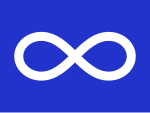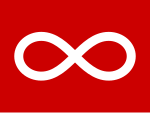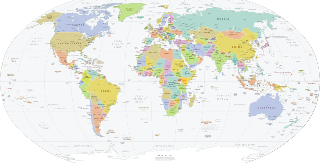
A country is a distinct part of the world, such as a state, nation, or other political entity. When referring to a specific polity, the term "country" may refer to a sovereign state, states with limited recognition, constituent country, or a dependent territory. Most sovereign states, but not all countries, are members of the United Nations. There is no universal agreement on the number of "countries" in the world since several states have disputed sovereignty status, limited recognition and a number of non-sovereign entities are commonly called countries.

The Commonwealth Games is a quadrennial international multi-sport event among athletes from the Commonwealth of Nations, which consists mostly, but not exclusively, of territories of the former British Empire. The event was first held in 1930 as the British Empire Games and, with the exception of 1942 and 1946, has successively run every four years since. The event was called the British Empire Games from 1930 to 1950, the British Empire and Commonwealth Games from 1954 to 1966, and British Commonwealth Games from 1970 to 1974. The event removed the word British from its title for the 1978 Games and has maintained its current name ever since.
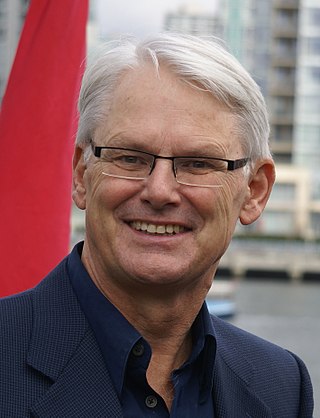
Gordon Muir Campbell, is a retired Canadian diplomat and politician who was the 35th mayor of Vancouver from 1986 to 1993 and the 34th premier of British Columbia from 2001 to 2011.

The Human Development Index (HDI) is a statistical composite index of life expectancy, education, and per capita income indicators, which is used to rank countries into four tiers of human development. A country scores a higher level of HDI when the lifespan is higher, the education level is higher, and the gross national income GNI (PPP) per capita is higher. It was developed by Pakistani economist Mahbub ul-Haq and was further used to measure a country's development by the United Nations Development Programme (UNDP)'s Human Development Report Office.
In Canada, an Indian reserve is defined by the Indian Act as a "tract of land, the legal title to which is vested in His Majesty, that has been set apart by His Majesty for the use and benefit of a band." Reserves are areas set aside for First Nations, one of the major groupings of Indigenous peoples in Canada, after a contract with the Canadian state, and are not to be confused with Indigenous peoples' claims to ancestral lands under Aboriginal title.

Hecate Strait is a wide but shallow strait between Haida Gwaii and the mainland of British Columbia, Canada. It merges with Queen Charlotte Sound to the south and Dixon Entrance to the north. About 140 kilometres (87 mi) wide at its southern end, Hecate Strait narrows in the north to about 48 kilometres (30 mi). It is about 260 kilometres (160 mi) in length.

Frank Arthur Calder, was a Nisga'a politician in Canada.

The Nisga’a (Niska), often formerly spelled Nishga or Niska and spelled in the Nisga'a language as Nisg̱a’a, are an Indigenous people in British Columbia, Canada. They reside in the Nass River valley of northwestern British Columbia. The origin of the term Niska is uncertain. The spelling Nishga is used by the Nishga Tribal Council, and some scholars claim that the term means 'people of the Nass River'. The name is a reduced form of, which is a loan word from Tongass Tlingit, where it means 'people of the Nass River'.

The Tsimshianic languages are a family of languages spoken in northwestern British Columbia and in Southeast Alaska on Annette Island and Ketchikan. All Tsimshianic languages are endangered, some with only around 400 speakers. Only around 2,170 people of the ethnic Tsimshian population in Canada still speak a Tsimshian language; about 50 of the 1,300 Tsimshian people living in Alaska still speak Coast Tsimshian. Tsimshianic languages are considered by most linguists to be an independent language family, with four main languages: Coast Tsimshian, Southern Tsimshian, Nisg̱a’a, and Gitksan.
Nisga’a is an indigenous language of northwestern British Columbia. It is a part of the language family generally called Tsimshianic, although some Nisga'a people resent the precedence the term gives to Coast Tsimshian. Nisga’a is very closely related to Gitxsan. Indeed, many linguists regard Nisga’a and Gitksan as dialects of a single Nass–Gitksan language. The two are generally treated as distinct languages out of deference to the political separation of the two groups.
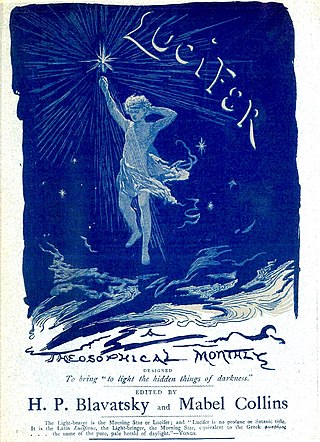
Lucifer was a journal published by Helena Blavatsky. The first edition was issued in September 1887 in London. The journal published articles on philosophical, theosophical, scientific and religious topics. It also contained book reviews, for example of Friedrich Nietzsche's Thus Spoke Zarathustra.
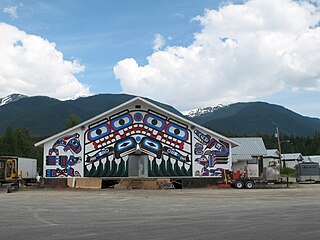
Gitlax̱t'aamiks, formerly New Aiyansh, is a Nisga'a village about 100 km (62 mi) north of Terrace, in the heart of the Nass River valley, Canada. It is one of four Nisga'a villages. Though it is located in British Columbia, it is also considered the "capital of the Nisga'a Nation". The Nisg̱a'a Lisims Government building, which opened in 2000, is located here. The area is home to 806 people and the Nisga'a Memorial Lava Bed Provincial Park. Gitlax̱t'aamiks is located overlooking a lava flow that erupted in the 18th century. The source for this lava flow was the Tseax Cone.

Treaty 8, which concluded with the June 21, 1899, signing by representatives of the Crown and various First Nations of the Lesser Slave Lake area, is the most comprehensive of the eleven Numbered Treaties. The agreement encompassed a land mass of approximately 840,000 km2 (320,000 sq mi). Treaty territory, which includes thirty-nine First Nation communities in northern Alberta, northwestern Saskatchewan, northeastern British Columbia, and the southwest portion of the Northwest Territories, making it the largest of the numbered treaty in terms of area. The treaty was negotiated just south of present-day Grouard, Alberta.
Nisga'a Highway, officially designated British Columbia Highway 113, is a highway in the Regional District of Kitimat-Stikine in British Columbia. It starts in Terrace at Highway 16. The route provides paved access to the settlements of the Nisga'a Nation - Gitlaxt'aamiks, Gitwinksihlkw, Gingolx (Kincolith), Laxgalts'ap (Greenville), Nass Camp and others. It enters the Nass Country via the valley of Kitsumkalum Lake, which connects from the Skeena and via the Nisga'a Lava Beds Provincial Park. The route heads north from Terrace and once into the Nass River Valley then travels west to Gingolx (Kincolith) for a total of 169 kilometres (105 mi). There is a 12-kilometre (7.5 mi) spur between New Aiyansh and Nass Camp.
The Nisga'a Final Agreement, also known as the Nisga'a Treaty, is a treaty that was settled between the Nisg̱a'a, the government of British Columbia, and the Government of Canada that was signed on 27 May 1998 and came into effect on May 11, 2000. As part of the settlement in the Nass River valley nearly 2,000 km2 (800 sq mi) of land was officially recognized as Nisg̱a'a, and a 300,000 cubic decametres (1.1×1010 cu ft) (approx. 240,000 acre-feet) water reservation was also created. Bear Glacier Provincial Park was also created as a result of this agreement. Thirty-one Nisga'a placenames in the territory became official names. The land-claim settlement was the first formal modern day comprehensive treaty in the province— the first signed by a First Nation in British Columbia since the Douglas Treaties in 1854 (pertaining to areas on Vancouver Island) and Treaty 8 in 1899 (pertaining to northeastern British Columbia). The agreement gives the Nisga'a control over their land, including the forestry and fishing resources contained in it.
Ron Joseph Telek was a Canadian First Nations sculptor. He is a member of the Laxsgiik of the Nisga'a nation of northwestern British Columbia, and carries the hereditary name of Jagam Txalp meaning Four Canoes Coming into the Village. Telek's primary medium for his sculptures is wood, although he also includes other materials such as bone, moose hair and abalone into his work.
The following is an alphabetical list of topics related to Indigenous peoples in Canada, comprising the First Nations, Inuit and Métis peoples.
Marie-Lucie Tarpent is a French-born Canadian linguist, formerly an associate professor of linguistics and French at Mount Saint Vincent University [MSVU], Halifax, Nova Scotia, Canada. She is known for her descriptive work on the Nisga'a language, a member of the Tsimshianic language family, and for her proof of the affiliation of the Tsimshianic languages to the Penutian language group.
This is a list of elections in Canada scheduled to be held in 2018. Included are municipal, provincial and federal elections, by-elections on any level, referendums and party leadership races at any level. In bold are provincewide or federal elections and party leadership races.



















